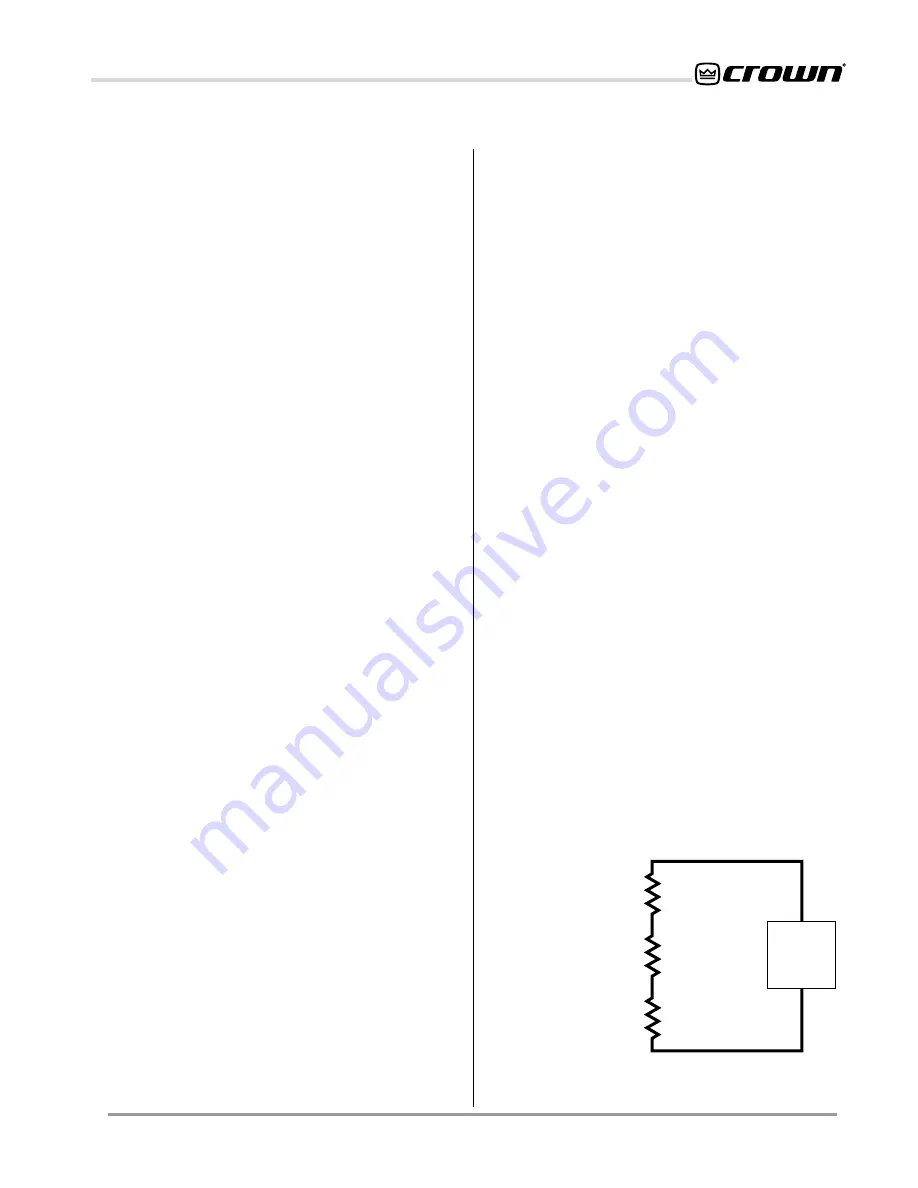
Page 21
Reference Manual
Macro-Tech
®
24x6 & 36x12 Power Amplifiers
5 Technical Information
5.1 Overview
Your amplifier incorporates several new technological
advancements including low stress output stages, real-
time computer simulation of output transistor stress, an
advanced heat diffuser embodiment and a modular
system for signal input and processing. In addition,
Macro-Tech 36x12 models also have an articulated VZ
power supply in Channel 1.
Custom protection circuitry limits temperature and cur-
rent to safe levels while making the amplifier highly reli-
able and tolerant of faults. Unlike many lesser
amplifiers, it can operate at its voltage and current limits
without self-destructing.
Real-time computer simulation is used to create an ana-
logue of the junction temperature of the output transis-
tors (hereafter referred to as the “output devices”).
Current is limited only when the device temperature
becomes excessive—and just by the minimum amount
necessary. This patented approach is called ODEP or
Output Device Emulation Protection. It maximizes the
available output power and eliminates overheating, the
major cause of output device failure.
The amplifier is protected from all common hazards that
plague high-power amplifiers, including shorted, open
or mismatched loads; overloaded power supplies, ex-
cessive temperature, chain-destruction phenomena,
input
overload damage and high frequency blowups.
The unit protects loudspeakers from DC in the input sig-
nal, turn-on and turn-off transients, and it detects and
prevents unwanted DC in the output. The amplifier is
also protected from internal faults.
The patented four-quadrant topology used in the
grounded output stages is called the grounded bridge.
The grounded bridge topology takes full advantage of
the power supplies delivering peak-to-peak voltages to
the load that are twice the voltage seen by the output
devices and twice the voltage generated by the power
supplies.
The grounded bridge topology is ground-referenced.
Because the required current exceeds the limits of pres-
ently available components, composite output devices
are constructed to function as gigantic NPN and PNP
devices. Each output stage has two composite NPN
devices and two composite PNP devices.
The devices connected to the load are referred to as
“high-side NPN and PNP” and the devices connected
to ground are referred to as “low-side NPN and PNP.”
Positive current is delivered to the load by increasing
conductance simultaneously in the high-side NPN and
low-side PNP stage, while decreasing conductance of
the high-side PNP and low-side NPN in synchrony.
A wide bandwidth, multiloop design is used for state-
of-the-art compensation. This produces ideal behavior
and results in ultra-low distortion values.
Aluminum extrusions have been widely used for
heatsinks in power amplifiers due to their low cost and
reasonable performance. However, measured on a
watts per pound or watts per volume basis, the extru-
sion technology doesn’t perform nearly as well as the
thermal diffuser technology developed for
Macro-Tech
power amplifiers.
Our thermal diffusers are fabricated from custom con-
voluted fin stock that provides an extremely high ratio of
area to volume, or area to weight. All power devices are
mounted directly to massive heat spreaders that are
electrically alive. Electrifying the heat spreaders im-
proves thermal performance by eliminating the insulat-
ing interface underneath the power devices. The
chassis itself is used as part of the thermal circuit, and
this maximizes utilization of the available resources.
5.2 VZ Power (Macro-Tech 36x12 only)
VZ means Variable Impedance and is the name of
Crown’s patented articulated power supply technology.
This technology is what makes it possible to pack such
tremendous power into Crown’s
Macro-Tech 3600VZ
and
Macro-Tech 5002VZ amplifiers. The high-power
channel of the Macro-Tech 36x12 uses this articulated
power supply technology.
5.2.1 Background
A power supply must be large enough to handle the
maximum voltage and current needed by the amplifier
to drive its maximum rated power into a specified load.
To fulfill this require-
ment, conventional
power supply de-
signs produce lots of
heat, are heavy, and
take up precious real
estate. And it’s no se-
cret that heat is one
of a power amplifiers
worst enemies. Con-
sider the circuit that
follows in Figure 5.1.
According to Ohm’s
Law, as your power
Fig. 5.1 A Typical
Power Supply
POWER
TRANSISTOR
POWER
TRANSISTOR
SPEAKER
LOAD
POWER
SUPPLY
+
–














































